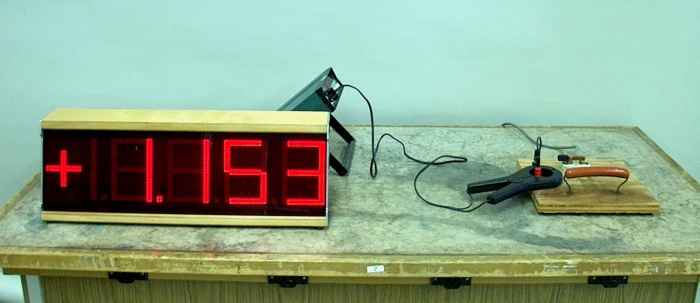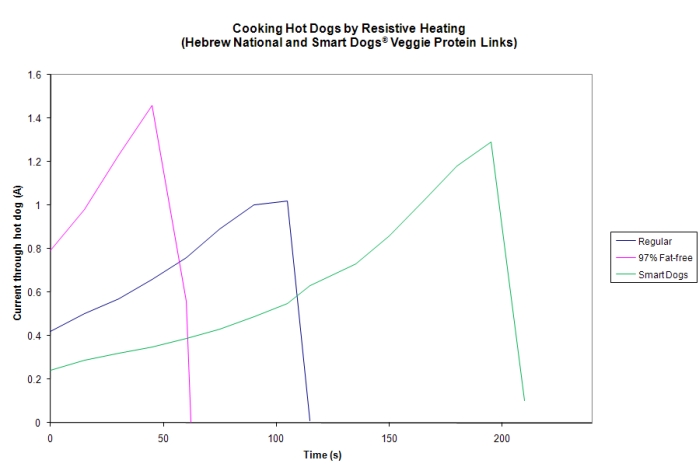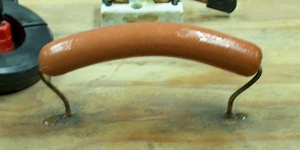
This demonstration illustrates in a rather tasty way the phenomenon of resistive heating. The apparatus on the right in the photograph above places the hot dog across the AC line when the knife switch is closed. Because a considerable portion of a hot dog&’s mass is water, and hot dogs also contain various salts and other water-soluble compounds that can act as charge carriers, hot dogs — at least those fresh from the package — conduct electricity. Thus, when you close the knife switch (assuming that the apparatus is plugged in), a current begins to flow through the hot dog. The inductive pickup connected to the multimeter allows you to monitor the current flowing through the hot dog. This is a 1000:1 dividing transformer. You must use a range of 20 mA or greater, and there is a zero offset of about +0.026 A on the 20-mA scale. (That is, 0.026 mA × 1000. You could also connect the meter directly – the current probe is on the neutral side – but beware that the maximum current capacity of the meter is 2 A.) The instrument must be set to AC MA, or else the hot dog cooker will not work. The current rises as the hot dog heats up, then, after the water has vaporized at least to the point where the hot dog can no longer conduct electricity, the current drops precipitously to zero, signifying the end of the cooking process. As the hot dog cooks, you may notice a darkening of the skin, and towards the end you will probably hear a gentle sizzling sound.
At right is a close-up of a hot dog that has just finished cooking. You can see a drop of juice at the base of each pin and one sitting between the left end of the hot dog and the pin.
Below is a plot of current vs. time for two hot dogs, one regular and one 97% fat free. This is a rather crude plot in that data were taken every 15 seconds (except for the last point in the first two curves, which was taken when the current dropped to zero), but it provides a reasonably good illustration of how hot dogs cook.

This device cooks the hot dog by means of a phenomenon called resistive heating. During the 1960s and ’70s, several companies made hot dog cookers in which one placed the hot dogs between pairs of pins, which cooked the hot dogs in this way. The current flow, i, through a resistor whose resistance is R, is proportional to V, the voltage across the resistor; V = iR; i = V/R. The units of voltage are J/C, of current, C/s, and of resistance, ohms (Ω). From these, we can see that the power dissipated in a resistor is P = iV (in J/s, or watts (W)), which also equals i2R. Thus, the power dissipated in the hot dog at a given time is the current passing through it multiplied by the line voltage (120 V, its rms value). For the plots above, the current changes over time. The total charge that has passed through each hot dog is the integral under each curve, and the average current for each hot dog is this integral divided by the time span over which it is calculated (so for the whole curve, the total charge divided by the end time). We can take the average power dissipated in each hot dog as this average current multiplied by 120 V, and the total energy delivered to the hot dog as the power multiplied by the end time.
You can find a reference to this demonstration here (The Physics Teacher, 13 50 (1975).
Health and safety notes:
CAUTION! When the unit is plugged in, one side of the knife switch is hot. As long as the knife switch is open, you may safely touch either or both of the nails on which the hot dog sits, but do NOT touch the metal parts of the knife switch. Operate the knife switch by means of the plastic handle ONLY. While the hot dog is cooking do not touch any part of the circuit. (Yes, you could touch the neutral side, but you would not want to risk touching anything that might be hot.) Make sure that you open the knife switch before you remove the hot dog from the nails.
The electric hot dog cooker will get the hot dog warm enough that it will be pleasant to eat, but perhaps not as hot as other methods such as broiling, pan frying or baking might get it. It will be perfectly safe to eat. Since hot dogs are precooked, they may be eaten right from the package. Cooking merely improves the flavor, and it is usually more pleasing to eat a hot frankfurter than a cold one.
When the hot dog has finished cooking, you may observe some arcing either on one end or both ends of the hot dog, which may char a small area around the nail. This will in no way make it unsafe to eat the hot dog. You should feel free to invite a student to enjoy it!
